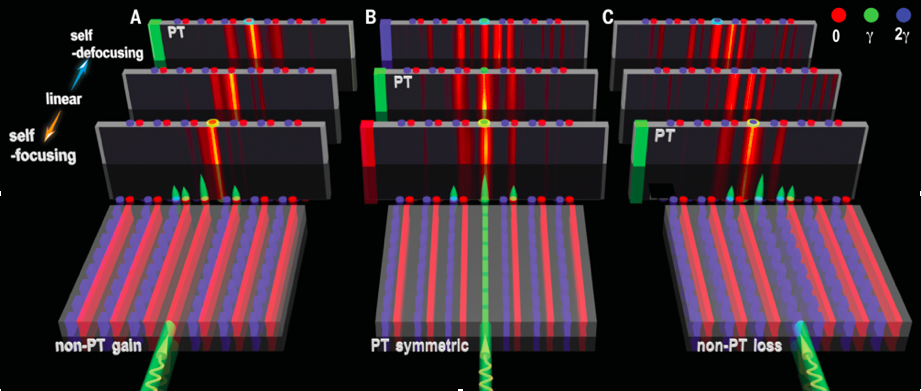For the first time it is possible to experimentally control the parity time (PT)-symmetry of topological states utilizing the Kerr nonlinear effect. In particular, optically induced photonics lattices realized a non-Hermitian nonlinear version of the Su-Schrieffer-Heeger (SSH) lattice. The experiments took place at the MOE Key Weak Nonlinear Optics Laboratory of Nankai University in China by the experimental group of Prof. Zhigang Chen with PhD students Shiqi Xia, Daohong Song and Jingjun Xu. Theoretical calculations were carried out by the group of Prof. Konstantinos G. Makris with PhD students Dimitrios Kaltsas and Ioannis Komis from the University of Crete, in collaboration with Prof. Alexander Szameit (Rostock University, Germany) and Hrvoje Buljan (University of Zagreb, Croatia).
The system consists of two non-Hermitian SSH topological sub-lattices that form an interface (see figure). In this work we showed that the Kerr nonlinearity can effectively alter not only the real but also the imaginary part of the index modulation. This means that, the PT-symmetry of the topological state can be recovered solely by tuning of the channel’s nonlinearity enabling thus the transition between the two different regimes. Local control of the interface channel affects the global features of the lattice, namely its topological and PT-symmetric nature.

Another interesting result is the study of two apparently antagonistic effects. In one hand, the system is sensitive close to exceptional points (due to non-Hermiticity) and in the other hand the zero eigenstate is robust (due to topology). In our NH-SSH lattice these effects are theoretically examined.
The theoretical and experimental work of the group was based on the synergy between three different concepts nonlinearity, non-Hermiticity, and topology, and thus led to the complex NH-SSH lattice, which may provide a new platform for novel phenomena and applications in the area of non-Hermitian Topological Photonics.
Paper: “Nonlinear tuning of PT symmetry and non-Hermitian topological states” by Shiqi Xia, Dimitrios Kaltsas, Daohong Song, Ioannis Komis, Jingjun Xu, Alexander Szameit, Hrvoje Buljan, Konstantinos G. Makris, Zhigang Chen, Science, 372, 72 (2021)




